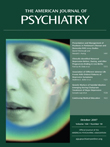Elevated Plasma Dopamine Metabolites in Cannabis Psychosis
To The Editor: Cannabis has received increasing attention as a risk factor for the development of psychotic states (1) . There are relatively little data related to the biochemical profile in cannabis psychosis (2 , 3) . We report on five consecutive cases of first-admission psychosis associated with documented cannabis use. For comparison, we used a consecutive series of first-admission psychosis and a group of nonpsychotic inpatients treated during the same period. We collected plasma for homovanillic acid on the first morning after admission following an overnight fast.
The first-admission cannabis psychosis group (N=5) had a mean age of 21.2 years. Urine tests were positive for cannabis subjects on admission. The comparison groups had urine samples negative for cannabinoids on admission. The first-episode psychosis group (N=15) had a mean age of 20.4 years, and the nonpsychotic group (N=17) had a mean age of 32.0 years. The psychosis groups did not significantly differ in age, race, sex, or level of psychosis. The degree of psychosis was rated as moderate on the four positive symptom items of the Brief Psychiatric Rating Scale.
Plasma homovanillic acid was measured using gas chromatography mass spectrometry with deuterated internal standards. Homovanillic acid levels were compared using a Student’s t test. Plasma homovanillic acid values were as follows: cannabis psychosis group, 24.8 ng/ml (SD=2.9); first-episode group, 15.1 ng/ml (SD=3.1); and nonpsychotic group, 9.6 ng/ml (SD=2.1). Homovanillic acid values for the cannabis group were significantly higher relative to the first-episode group (p<0.001) and the nonpsychotic group (p<0.001). Homovanillic acid values for the first-episode group were significantly higher when compared with the nonpsychotic group (p<0.001).
To our knowledge, this is the first report of elevated plasma homovanillic acid in cannabis-related psychosis, although we are aware of a report of elevated urinary homovanillic acid following cannabis administration to a volunteer population (2) .
In this small case series of patients with first-episode psychosis associated with cannabis use, plasma homovanillic acid was significantly higher than values for each of the comparison groups. There are several possibilities for this result. First, plasma homovanillic acid is elevated in a number of newly admitted psychosis patients (4) , which was the case in our first-episode psychosis group. However, plasma homovanillic acid was even higher in the cannabis group. Second, acute cannabis administration can produce increased dopamine activity in animals and humans (2 , 3) . Third, individuals with cannabis psychosis may also have a genetic vulnerability that can lead to increased dopaminergic activity (1) .
1. Henquet C, Rosa A, Krabbendam L, Papiol S, Fananas L, Drukker M, Ramaekers JG, van Os J: An experimental study of catechol- o -methyltransferase Val158Met moderation of delta-9-tetrahydrocannabinol-induced effects on psychosis and cognition. Neuropsychopharmacology 2006; 31:2748–2757 Google Scholar
2. Markianos M, Vakis A: Effects of acute cannabis use on urinary neurotransmitter metabolites and cyclic nucleotides in man. Drug Alcohol Depend 1984; 14:175–178Google Scholar
3. Bowers MB, Morton JB: Regional brain catecholamines and metabolites following THC, PCP and MK-801. Prog Neuropsychopharmacol Biol Psychiatry 1994; 18:961–964Google Scholar
4. Bowers MB, Swigar ME: Acute psychosis and plasma catecholamine metabolites. Arch Gen Psychiatry 1987; 44:190Google Scholar



